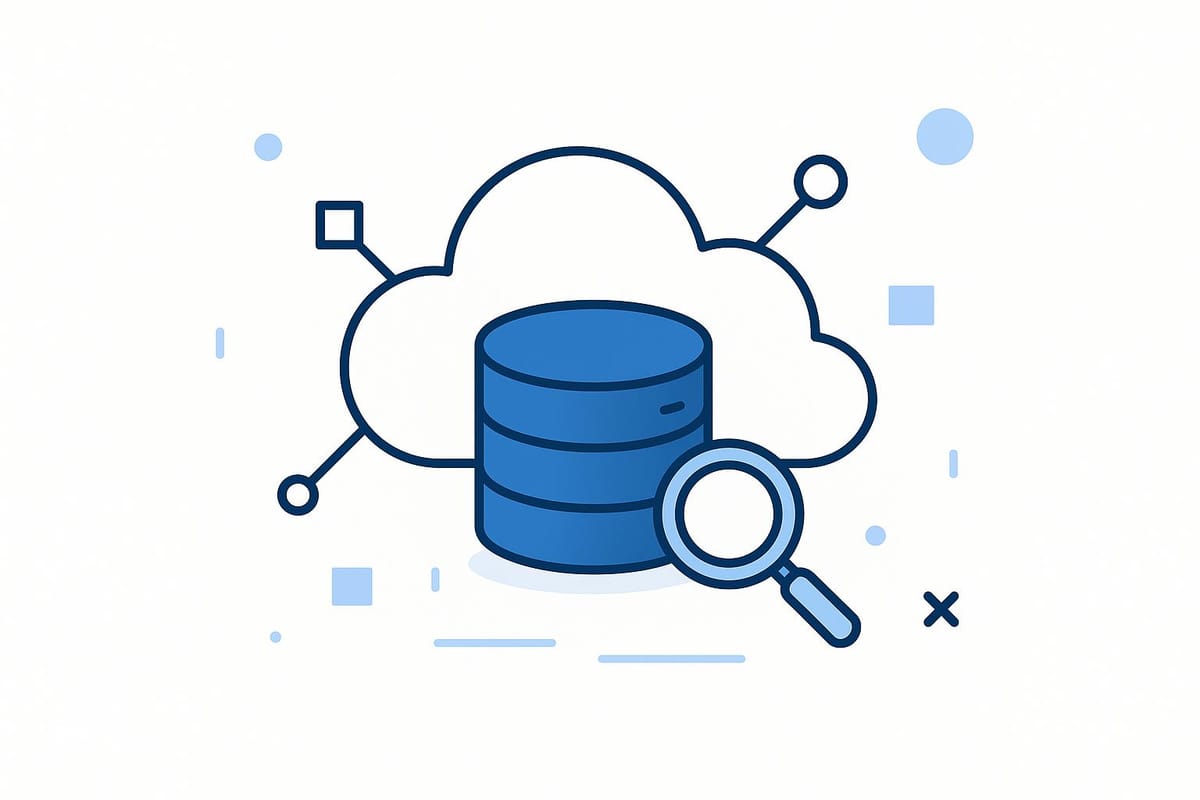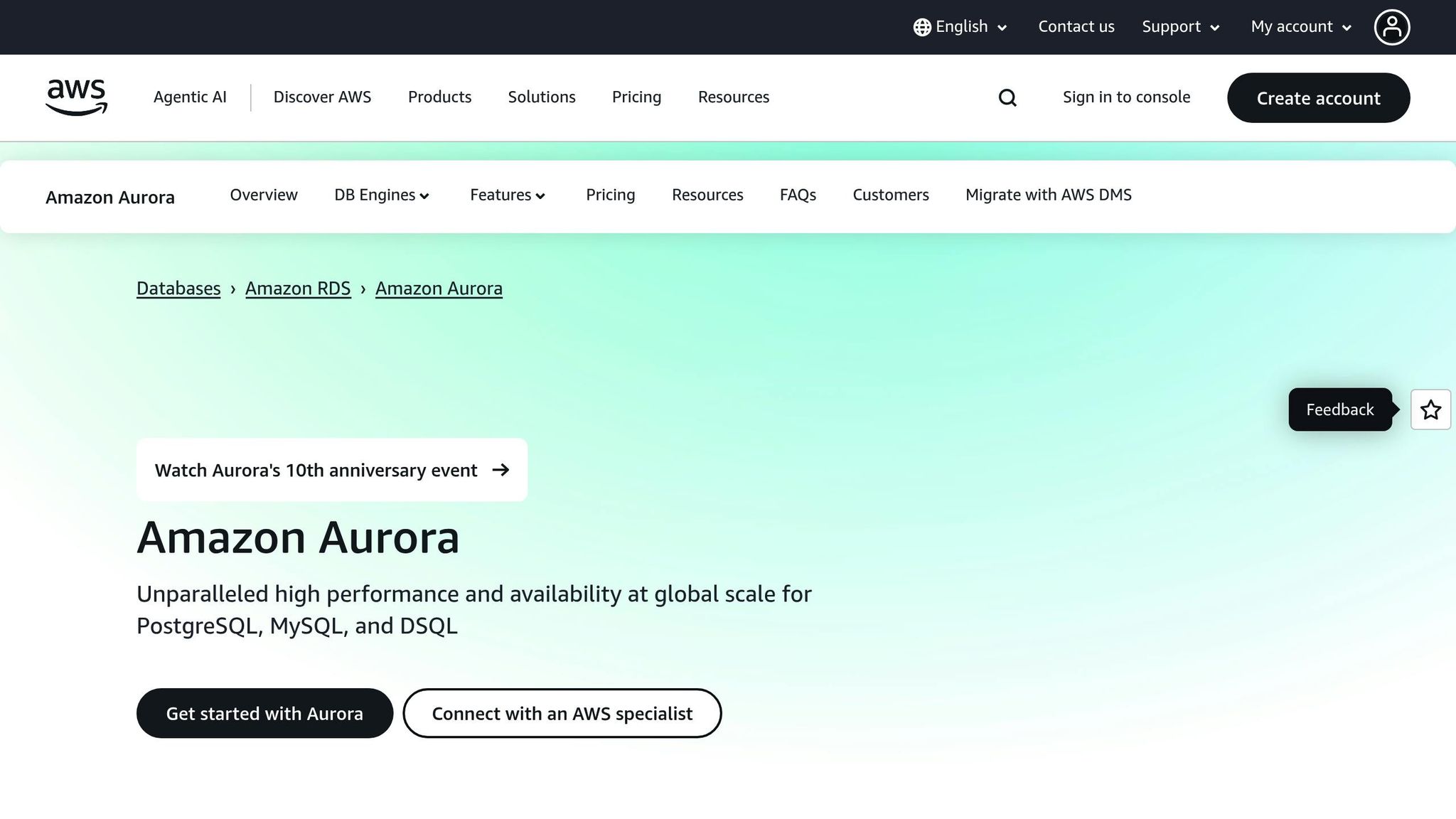Indexing Best Practices for AWS Databases
Learn essential indexing best practices for AWS databases to enhance performance and manage costs effectively, tailored for UK SMBs.

Database indexing on AWS can significantly improve your application's performance and reduce costs, but only if done correctly. Here's what you need to know to get started:
- Indexing Basics: Indexes act as shortcuts for data retrieval, speeding up reads but potentially slowing down writes. Striking the right balance is key.
- AWS Services: AWS databases like RDS, DynamoDB, DocumentDB, and Aurora offer different indexing options tailored to specific needs.
- Challenges for UK SMBs: Poorly optimised indexes can increase AWS bills and complicate compliance with GDPR. Regular monitoring and adjustments are essential.
- Index Types: Primary, composite, partial, and full-text indexes each serve different purposes. Choose based on your workload - transactional or analytical.
- Maintenance & Monitoring: Tools like AWS Performance Insights, CloudWatch, and PostgreSQL's
pg_stat_statementshelp track index usage and health. - Cost Management: Unused indexes waste storage and resources. Regular clean-ups and smart indexing strategies can save money.
AWS Database Indexing Strategies
Primary and Secondary Indexes
Primary indexes serve as the backbone of database performance, acting as the main access point for retrieving data. In Amazon RDS, primary indexes are automatically created on primary keys and enforce uniqueness constraints. These indexes, built using B-tree structures, ensure quick search times and maintain data integrity across PostgreSQL and MySQL instances.
Aurora takes indexing a step further by blending traditional methods with cloud-specific enhancements, boosting OLTP performance by up to 5× for MySQL and 3× for PostgreSQL. Aurora also reduces the need for manual tuning by automatically optimising index usage based on query patterns, making it a more hands-off option compared to self-managed databases.
Advanced Index Types and When to Use Them
For more complex use cases, advanced indexing options provide tailored performance improvements.
- Composite indexes are ideal for multi-column queries. By indexing multiple columns together, these indexes can cut query response times by up to 40% compared to single-column indexes. To maximise their efficiency, place the most selective columns at the beginning of the index.
- Partial indexes in PostgreSQL are a smart way to save storage and boost performance. They index only rows that meet specific conditions, such as active customer records while excluding archived ones. This approach can reduce read I/O by an average of 27% in PostgreSQL workloads exceeding 500 GB.
- GIN (Generalised Inverted Index) indexes shine when dealing with complex data types like arrays and JSON documents. In PostgreSQL, they can improve query performance by up to 60% for tasks like containment queries and full-text searches, compared to sequential scans.
- Full-text indexes are a game-changer for text-heavy queries, making full-text lookups 10–30× faster than linear scans on datasets with over 500,000 rows. For UK-based SMBs managing customer support tickets or product descriptions, this improvement can significantly enhance user experience during busy periods.
- Covering indexes include all the columns required for a query directly within the index, eliminating the need to access the main table. This approach is particularly effective for summary data or reporting queries that rely on specific subsets of columns.
Indexing for Transaction vs Analytics Workloads
Your indexing strategy should align with the type of workload - whether it's handling high-speed transactions or processing large-scale analytics.
- Transactional workloads (OLTP) focus on fast, frequent operations with small result sets. Amazon RDS and Aurora rely on traditional B-tree indexes to maintain data consistency while supporting high transaction volumes. These workloads benefit from indexing foreign keys, commonly filtered columns, and join conditions. High-cardinality columns, like customer IDs or timestamps, can make filtering queries 40–60% faster.
- Analytical workloads (OLAP) have different requirements. Amazon Redshift uses columnar storage with sort keys and distribution keys instead of traditional indexes. This architecture is well-suited for large-scale queries, such as aggregating monthly sales data or analysing customer behaviour. For instance, a hybrid system maintained sub-100 ms response times for OLTP while simultaneously updating analytical dashboards.
- Write-heavy applications need careful index management, as every insert, update, or delete operation must update all associated indexes. A 2019 AWS study revealed that over 30% of RDS clusters were using unnecessary indexes, wasting storage. In such cases, minimising indexes on frequently updated tables is essential. Aurora's Automatic Indexing feature can adapt to changing workloads without manual intervention, while the RDS Index Advisor offers automated recommendations, potentially reducing query execution time by over 25% in production environments.
Using AWS Aurora For Full Text Search - Complete Tutorial

Index Maintenance and Performance Monitoring
Keeping a close eye on index health can help you avoid performance slowdowns. AWS provides several tools to ensure your indexes run smoothly. Pairing regular maintenance with strategic index creation is key to getting the best performance out of your AWS databases.
Regular Index Health Checks and Monitoring
AWS offers tools like Performance Insights for RDS and Aurora, which monitor index usage and resource consumption in real time. These tools help you identify when an index is causing performance issues or consuming too many resources.
For PostgreSQL workloads, the pg_stat_statements extension is a valuable tool. It tracks query execution and index usage statistics, capturing metrics like execution time, call counts, and I/O stats. To enable it, add pg_stat_statements to the shared_preload_libraries parameter in your RDS parameter group.
Amazon CloudWatch is another go-to monitoring tool, offering metrics like DatabaseConnections, ReadLatency, WriteLatency, and ReadIOPS. For example, a sudden spike in read latency could indicate missing indexes, while higher write latency might suggest too many indexes on frequently updated tables.
If you're using DynamoDB, CloudWatch also tracks metrics like ConsumedReadCapacityUnits and ConsumedWriteCapacityUnits. These metrics can help you ensure Global Secondary Indexes (GSIs) aren’t using excessive capacity. Additionally, keep an eye on ThrottledRequests to spot under-provisioned indexes.
AWS X-Ray adds another layer with distributed tracing, giving you insights into how database queries perform within your application. This can help pinpoint slow queries that might benefit from better indexing or optimisation.
Once you've identified issues, the next step is to address redundant or unused indexes.
Finding and Removing Unused Indexes
Indexes that aren’t used can waste storage and slow down write operations. PostgreSQL's pg_stat_user_indexes view is a great tool for spotting these. Focus on indexes with zero or very low idx_scan values, as they’re likely not contributing to performance.
Here’s a query to find unused indexes since the last statistics reset:
SELECT schemaname, tablename, indexname, idx_scan
FROM pg_stat_user_indexes
WHERE idx_scan = 0;
For MySQL, the INFORMATION_SCHEMA.INDEX_STATISTICS table (available in Percona Server) or the sys.schema_unused_indexes view (MySQL 5.7 and later) can provide similar insights.
Before removing an index, monitor its usage over a full business cycle. An index might seem unused during regular operations but could be critical for specific reports, like month-end or quarterly analyses. To be cautious, test the impact of dropping an index in a controlled environment before making changes in production.
In addition to unused indexes, fragmented indexes can also hurt performance.
Managing Index Bloat
Index bloat happens when indexes become fragmented or contain dead space, which increases storage needs and slows queries. PostgreSQL is particularly prone to this due to its MVCC (Multi-Version Concurrency Control) architecture.
You can monitor bloat levels using the pgstattuple extension, which provides details on dead space through functions like pgstatindex(). If an index has over 20% dead space, it’s time to rebuild it.
PostgreSQL offers two options for fixing bloat: REINDEX and REINDEX CONCURRENTLY. The standard REINDEX locks the table during the process, which can disrupt availability. However, the concurrent version (available from PostgreSQL 12 onwards) allows the index to remain accessible, though it requires extra disk space during the rebuild.
Schedule index rebuilds during off-peak hours, such as 2:00 AM to 5:00 AM GMT, to minimise disruptions - especially for UK SMBs serving customers across multiple time zones.
Aurora automates some index maintenance tasks through its storage engine, but it’s still a good idea to monitor bloat metrics. For heavily updated tables, manual intervention might be necessary.
To reduce the need for frequent rebuilding, set appropriate fillfactor values - typically 80–90% for indexes that are frequently updated. This leaves space for updates without triggering immediate page splits. Regular VACUUM operations also help reclaim dead space before it becomes a problem.
For environments with high transaction volumes, you can automate index maintenance. For instance, AWS Lambda functions can run scheduled scripts to monitor bloat levels and trigger rebuilds when necessary. This ensures your indexes stay efficient without requiring constant manual oversight.
Cost Control and Performance Tuning for SMBs
For UK small and medium-sized businesses (SMBs), managing the balance between performance and AWS costs is essential. One effective way to achieve this is by fine-tuning indexing strategies. Building on earlier discussions about index selection and maintenance, this section dives into how SMBs can optimise performance while keeping costs in check.
Balancing Index Count with Write Performance
Indexes are a double-edged sword: while they speed up read operations, they can slow down writes. This happens because every insert, update, or delete operation must also update the relevant indexes. This trade-off is especially critical in applications with high transaction volumes.
A practical approach is to apply the 80/20 rule - focus on optimising indexes for the most frequent queries rather than trying to cover every single use case. Tools like Performance Insights or CloudWatch metrics can help identify your application's primary read patterns. Once you've pinpointed these, build indexes tailored to those specific needs.
For write-heavy applications, PostgreSQL partial indexes can be a game-changer. These indexes apply only to rows meeting specific conditions, reducing the maintenance burden while still delivering efficient query performance. Similarly, composite indexes can combine multiple query filters into a single index, cutting down on the total number of indexes required.
It’s worth noting that indexes don’t just affect performance - they also have a direct impact on your AWS bill.
AWS Database Indexing Costs
Understanding how indexes influence costs is key to deciding which ones are truly necessary. For instance, in DynamoDB, Global Secondary Indexes (GSIs) come with additional expenses for storage and provisioned capacity. Adding multiple GSIs can significantly increase your read and write costs. If your workload is unpredictable, DynamoDB on-demand pricing might be a more economical option.
Other AWS services, like DocumentDB, charge separately for the storage used by indexes, which is added on top of document storage costs. In traditional RDS databases (e.g., PostgreSQL), index storage contributes to overall data storage costs. Conducting a thorough review of your indexes - and removing any that are unused or redundant - can lead to noticeable savings.
For testing indexing strategies in non-production environments, Aurora Serverless v2 offers a pay-as-you-go model, which helps reduce costs.
Data Archiving and Partitioning for Better Indexing
Streamlining active data is another way to improve indexing efficiency and manage costs. Keeping your active dataset lean not only enhances performance but also reduces storage expenses. Table partitioning splits large tables into smaller, manageable segments, each with its own optimised indexes. For example, PostgreSQL's declarative partitioning is ideal for time-series data, allowing you to partition records by month or quarter. This reduces the size of indexes in each partition, making them more efficient.
Automating data archiving can also help control data volume and indexing overhead. Using AWS Lambda functions triggered by CloudWatch Events, you can automatically move older records to more cost-effective storage options like S3 Glacier. Features like Aurora's parallel query even allow you to query archived data directly from S3, avoiding unnecessary strain on your primary database.
In DynamoDB, implementing Time to Live (TTL) automatically removes outdated records, keeping table and index sizes manageable. For reporting and analytics workloads that require different indexing strategies, consider leveraging read replicas. This way, your primary database remains optimised for transactional performance, while read replicas handle additional indexes for analytics without impacting overall system performance.
For more tailored tips on AWS optimisation, cost management, and best practices for UK SMBs, check out AWS Optimisation Tips, Costs & Best Practices for Small and Medium-Sized Businesses.
Index Types Comparison and Use Cases
This section dives into a side-by-side comparison of index types to guide your AWS database optimisation efforts. Picking the right index type can make all the difference when it comes to database performance. Each index type serves a distinct purpose, and knowing their strengths and limitations allows you to align them with your workload needs.
B-tree indexes are the backbone of many database systems. They shine when it comes to range queries and sorting, making them a great fit for transactional workloads that need ordered results. For example, in AWS RDS PostgreSQL, B-tree indexes work well for tasks like finding all orders within a date range or listing customer records alphabetically. However, they can struggle with very large datasets and need regular upkeep to avoid inefficiencies.
Hash indexes, on the other hand, excel at equality lookups. They’re incredibly fast when you need to find an exact match, such as during user authentication or when retrieving products by unique identifiers. DynamoDB’s primary key relies on hash-based distribution, which is why single-item lookups are so quick. The downside? Hash indexes don’t support sorting or range-based searches.
Composite indexes combine multiple columns into a single structure, making them ideal for queries that filter on several fields. The trick here is to arrange the columns wisely - starting with the most selective ones usually yields the best performance.
Partial (or filtered) indexes are designed to index only rows that meet certain conditions, cutting down on storage and maintenance needs. For instance, if most of your orders are completed but your queries focus on active orders, creating a partial index for active orders can significantly boost performance while using less storage.
To make these distinctions clearer, here’s a quick comparison:
Index Types Comparison Table
| Index Type | Best Use Cases | Performance Impact | Cost Considerations | Key Limitations |
|---|---|---|---|---|
| B-tree | Range queries, sorting, transactional workloads | Fast reads, moderate write overhead | Standard storage costs, regular maintenance needed | Can become bloated, less efficient for very large tables |
| Hash | Exact match lookups, user authentication | Fast equality searches, minimal write impact | Low storage overhead | No range queries, no sorting support |
| Composite | Multi-column filters, complex query patterns | Excellent for matching queries, higher write cost | Higher storage usage, maintenance complexity | Column order critical, can be over-specific |
| Partial/Filtered | Subset-focused queries, conditional data | Reduced storage, faster maintenance | Significant cost savings on storage | Limited applicability, query planner complexity |
| Global Secondary (DynamoDB) | Alternative access patterns, cross-partition queries | Flexible querying, additional capacity consumption | Separate read/write capacity charges | Eventually consistent, additional complexity |
| Local Secondary (DynamoDB) | Same partition key, different sort patterns | Strongly consistent reads, shared capacity | Uses table's capacity, 10GB partition limit | Same partition key required, size limitations |
Your choice of index type depends heavily on whether you’re dealing with transactional workloads or analytical workloads. Transactional systems, which involve frequent small transactions and high concurrency, benefit from B-tree and hash indexes. These indexes support fast lookups and maintain high buffer cache hit ratios, often above 99%. Smaller database block sizes, typically 8KB or less, also work well for these workloads.
Analytical workloads, on the other hand, often involve processing large datasets. Composite indexes can help by avoiding full table scans, and partial indexes are particularly useful for reducing the data processed during large queries.
When planning your indexing strategy, start by analysing your query patterns, then weigh the costs. A carefully selected set of indexes can drastically improve performance while keeping costs in check. However, over-indexing can quickly lead to inefficiencies and higher expenses. By understanding the differences between these index types, you can fine-tune your AWS databases to balance performance and cost effectively.
Key Takeaways for UK SMBs
Main Lessons for SMBs
Getting your AWS database indexing right can significantly improve how your operations run and help manage costs effectively. The strategies outlined here build on the broader AWS indexing practices discussed earlier. For UK SMBs, often working with limited budgets, the challenge lies in balancing performance with expenses.
Focus on query patterns first, not on creating indexes. Before diving into index creation, spend time analysing how your applications access data. Monitor your database over a two-week period to identify the most frequent and resource-intensive queries. This proactive approach prevents over-indexing, which can slow down write operations and inflate AWS costs. By aligning your indexes with actual application usage, you set a solid foundation for both performance and cost management.
Choose the right index type for your needs. Earlier, we discussed various index types and their use cases. Refer back to the comparison table to ensure you're selecting the one that fits your workload best.
Set up CloudWatch alerts to keep track of index health and performance. Unused indexes not only waste valuable storage space but can also negatively impact write speeds. Regularly review and clean up unused indexes to maintain efficiency.
Strike a balance between write performance and read optimisation. While additional indexes can improve read speeds, they may slow down write operations. For most UK SMBs, aiming for 3–5 indexes per table is a good rule of thumb. If write speeds become an issue, review your existing indexes before considering an upgrade to a more expensive database instance.
Tailoring your indexes can also boost efficiency. Partial indexes are particularly useful if your queries often filter by status fields or date ranges. They require less storage while still delivering excellent performance.
Plan for growth without overcomplicating your setup. As your business grows and datasets expand from thousands to millions of records, your indexing strategy should adapt. Conduct quarterly performance reviews to stay ahead of scaling challenges and avoid unnecessary complexity.
Consider DynamoDB for predictable workloads. If your application has consistent access patterns, DynamoDB might be a cost-effective option. However, be cautious when designing indexes, as capacity costs can add up quickly.
For more tips on optimising your AWS infrastructure, check out AWS Optimization Tips, Costs & Best Practices for Small and Medium sized businesses. This resource offers expert advice tailored specifically for SMBs navigating the AWS ecosystem. By following these practical strategies, you can ensure your indexing approach keeps pace with both your performance goals and budget constraints.
FAQs
What are the best practices for UK SMBs to optimise database indexing in AWS while controlling costs?
To make database indexing more efficient in AWS while keeping costs under control, UK SMBs should prioritise smart indexing strategies and cost tracking. Regular maintenance and review of indexes are key to avoiding over-indexing, which can lead to unnecessary storage and processing expenses. Instead, focus on creating specific indexes that address particular queries and remove any fragmented or unused ones to streamline performance.
AWS offers tools like Cost Explorer and Compute Optimizer that can help analyse usage patterns and highlight areas where savings are possible. Another option to consider is using read replicas to distribute query loads, which can boost efficiency without adding excessive costs. By aligning indexing practices with actual workload demands and staying mindful of expenses, SMBs can strike the right balance between performance and budget.
What are the key benefits of Aurora's Automatic Indexing compared to managing indexes manually in other AWS databases?
Aurora's Automatic Indexing takes the hassle out of database management by automating the process of creating, updating, and removing indexes. This means your queries run efficiently without the need for hands-on intervention, saving time and minimising the chance of mistakes.
What sets this apart from traditional manual index management is its ability to adjust in real time to shifting workloads. Instead of requiring constant oversight and fine-tuning, Aurora's system adapts on its own. This is especially useful for businesses aiming to simplify operations and concentrate on growing their applications with ease.
How can businesses identify and safely remove redundant or unused indexes in AWS databases?
To spot redundant or unused indexes in AWS databases, businesses can tap into tools like CloudWatch metrics, database-specific diagnostics, or built-in features such as index usage analysis. For example, DynamoDB and DocumentDB offer metrics to monitor how indexes are being used, while PostgreSQL includes utilities to identify those that aren't serving a purpose.
Before deciding to remove an index, it's crucial to take a few precautionary steps. Start by creating a backup of the database using snapshots. Then, evaluate how the change might affect query performance, and once the index is removed, keep a close eye on the system to ensure everything runs smoothly. This careful process helps maintain a stable and efficient database environment.




